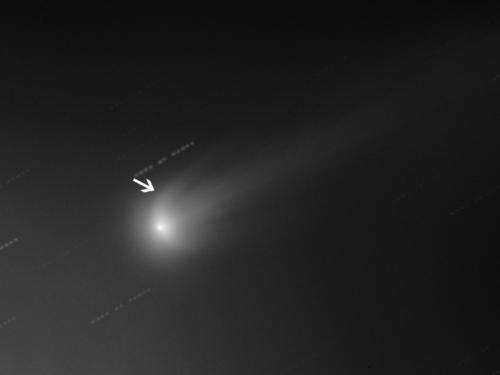The comet is centre stage: this image shows the gaseous environment of comet ISON with two wing-like structures which look like an elongated U (arrow). The nucleus is shown as a bright spot in the centre for orientation. Credit: Wendelstein Observatory / MPS
One or more chunks could have split off from the nucleus of comet ISON in recent days. Two wing-like structures in the gaseous environment of the comet, which have been photographed by a team of scientists from the Max Planck Institute for Solar System Research and the Wendelstein Observatory of the Ludwig Maximilian Universität Munich, seem to indicate this; the structures appear on images which were taken at the end of last week. This detachment of individual pieces of debris could possible explain the comet's recent increase in brightness.
Comet ISON has disappointed many amateur astronomers on its journey towards the Sun. The brightness of the comet, which will pass by the Sun's surface on 28 November at a relatively close distance of just over a million kilometres, did not increase as much as initially hoped. At the end of last week, the luminosity of ISON rose dramatically with several observers reporting a considerable increase in brightness.
A possible indication for the cause of the flare up is now provided by images of the comet which were taken and recently evaluated by scientists at the Wendelstein Observatory and the Max Planck Institute for Solar System Research. On 14 and 16 November they pointed their telescope towards the comet.
The analyses show two conspicuous structures in the comet's atmosphere which extend from the nucleus like wings. While these "wings" were still quite weak on 14 November, they clearly dominate the images taken two days later. "Such structures typically occur after individual fragments have split off from the nucleus of a comet," says Hermann Böhnhardt from the Max Planck Institute for Solar System Research.
Like the nucleus of the comet, its fragments also eject gas and dust into space. Where the emissions of the comet and the smaller chunks meet, a type of separating layer is generated, and this often has a wing-like character. Whether the increase in brightness seen in recent days was also caused by the fragments splitting off "cannot be said with certainty," says Böhnhardt. This relationship has been proven for other comets, however.
The wing-like structures on the images cannot be recognised with the naked eye, numerical methods are needed to make them appear in processed images. To this end the researchers scan the gaseous environment of the comet on the computer for changes in brightness. The uniformly bright background of the comet's atmosphere is subtracted and can thus no longer eclipse the weak structures. "Our computations indicate that either only a single chunk split off or that only very few pieces of debris were released," says Böhnhardt.
It is still unclear how the comet will behave in the coming weeks as it journeys around the Sun. "However, past experience has shown that comets which have lost fragments once have a tendency to do so again," says the comet researcher.
Provided by Max Planck Society
























